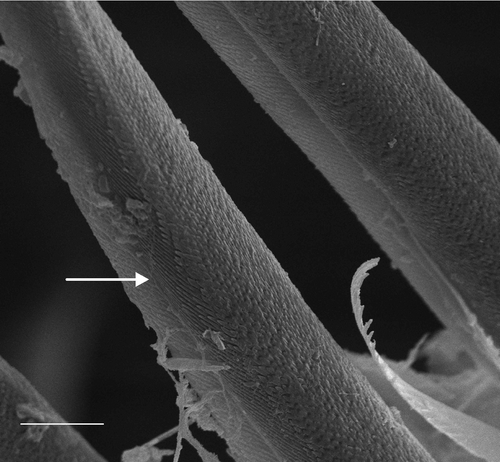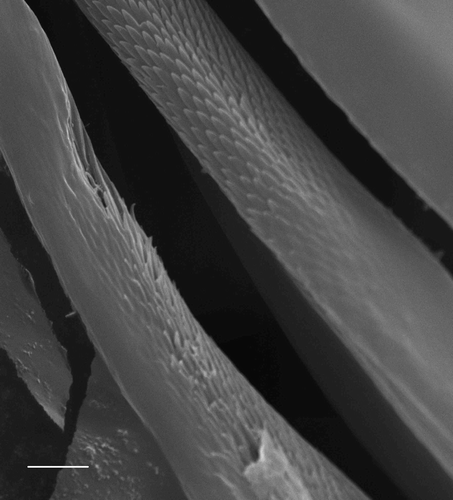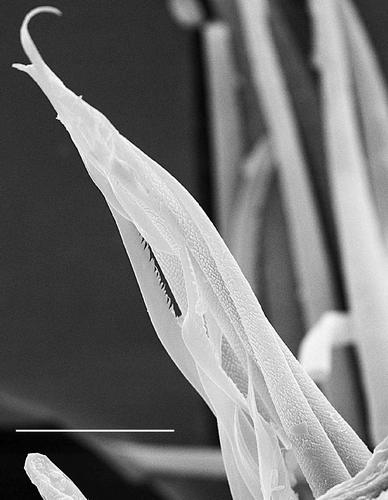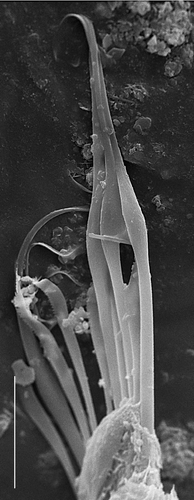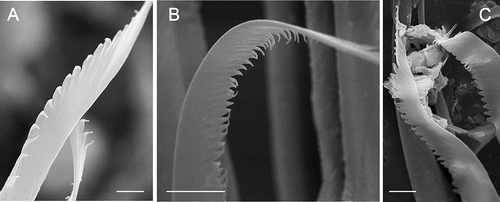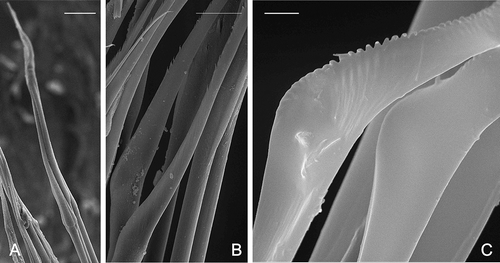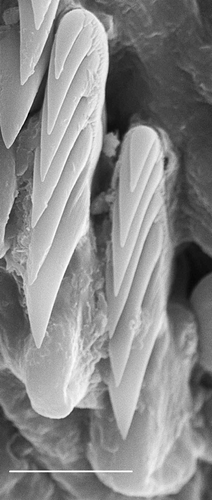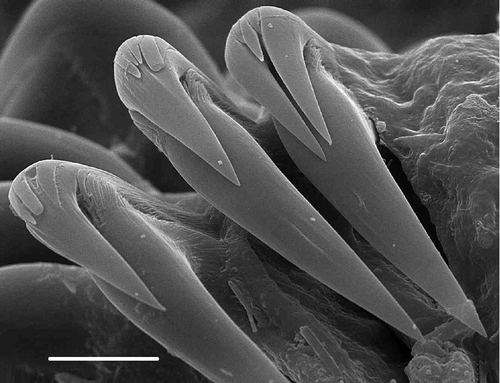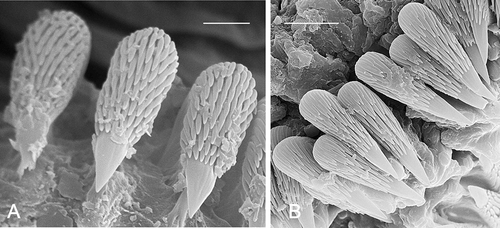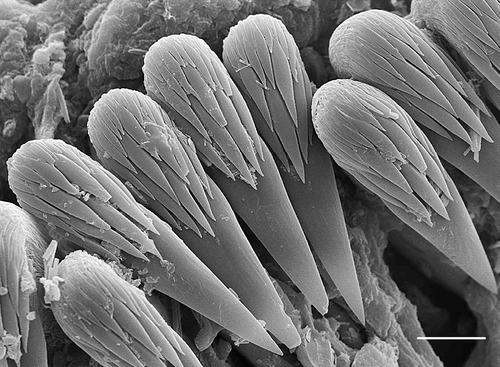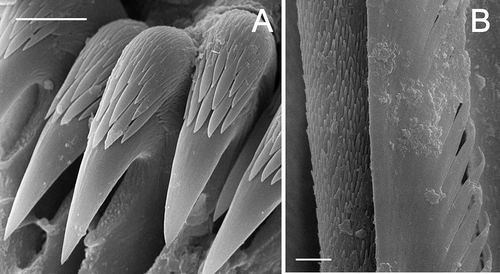Abstract
We studied the taxonomical value of morphology of notochaetae and uncini of Terebellinae for generic diagnostics in 25 species (15 genera) using scanning electron microscopy. Whenever possible, specimens collected from the type localities were studied. The usefulness of chaetal characters for generic definitions within Terebellinae is discussed.
Keywords:
Introduction
The chaetae of members of Terebellinae, as in most polychaetes, are currently one of the main morphological structures used for taxonomical purposes (Day Citation1967; Hartmann-Schröder Citation1971, Citation1996; Fauchald Citation1977; Holthe Citation1986; Hutchings & Glasby Citation1988; McHugh Citation1995; Jirkov Citation2001; Nogueira et al. Citation2010). However, their fine structure has not been completely studied until now. The main objective of the present study is to obtain new information about the chaetal structure using scanning electron microscopy (SEM) for taxonomic purposes.
Material and methods
For the present study, 25 species from 15 genera have been investigated (listed in the Appendix). Eleven species from this number have not been investigated by Nogueira et al. (Citation2010). Specimens were obtained from the collections of (1) Department of Hydrobiology, Moscow State University, Russia; (2) Thomson Unicomarine Ltd; and (3) Zoological Museum of Moscow State University. Whenever possible, specimens collected from type localities were studied.
Notopodia of the first and second chaetiger, complete neuropodia of the first unciniger, the last thoracic unciniger, the first abdominal and one of the posterior uncinigers were removed and mounted for SEM examination at the Moscow State University SEM laboratory.
Results and discussion
Notochaetae
The results of our study confirm the results of Hutchings and Glasby (Citation1988) and Nogueira et al. (Citation2010) based on other species that there are no smooth notochaetae in members of the Terebellidae. When examined under a compound microscope, chaetae that look smooth are in reality covered with minute denticles or hairs (hirsute). Axionice spp. and Nicolea spp. also have hirsute notochaetae, contrary to the accepted literature in generic diagnosis (Day Citation1967; Hartmann-Schröder Citation1971, 1996; Fauchald Citation1977; Holthe Citation1986) ().
Figure 1. Notochaetae: A, Amphitritides gracilis (Black Sea, scale 3 μm); B, Axionice mirabilis (30°30′ N, 129°19′ E, 824 m, scale 10 μm); C, Nicolea zostericola (73°52′ N, 162°35′ W, 240 m, scale 3 μm).
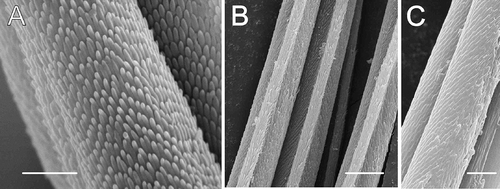
Nogueira et al. (Citation2010) proposed a new classification of notochaetae in the Terebellinae, describing notochaetae as either (A) distally winged, or (B) distally serrate. Distally winged chaetae consist of three types: (A1) narrowly winged chaetae, (A2) broadly winged chaetae, and (A3) hirsute chaetae. The distally serrate chaetae consist of four types: (B1) saw-like chaetae, (B2) limbate and serrated chaetae, (B3) deep-cut chaetae, and (B4) Spinosphaera-chaetae. The last two types were found only in species which do not occur in the investigated area.
In our material, it is possible to distinguish notochaetae of only two types: short chaetae with a distally large tooth and long hirsute chaetae. These two types may be distal points of a cline. Often, chaetae with large denticles are totally hirsute. Long hirsute chaetae have a large keel, and the tips of the hairs nearest to the keel are directed towards it. It appears that hairs form dents on the keel tip. We observe this change forming dents from hairs along the single chaeta in Amphitrite spp. (, pointed). The bases of the chaetae are densely hirsute and have a keel; distally, hairs gradually disappear and the keel becomes dentate. The same change was observed in Leaena (). Often both types of chaetae can be found in a single notopodia, and form two separate tufts: one with hirsute chaetae and the other with chaetae with smooth tips and a large tooth (). Notopodia of Eupolymnia spp. have only long hirsute chaetae with a large keel along the entire chaeta ().
The presence of notochaetae of two types in a single notopodia casts doubt on the validity of Phisidia, because the main diagnostic character of the genus is the presence of two notochaetal types. These two types are short chaetae with a large distal tooth and long hirsute geniculate chaetae (). However, short smooth notochaetae with large tooth were present in almost all investigated Terebellinae genera (). We found long hirsute geniculate chaetae in Amphitrite spp. and Amphitritides gracilis ().
Uncini
The shape of Terebellinae uncini varies considerably. Nogueira et al. (Citation2010) did not propose any classification of Terebellinae uncini; neither did Garrafoni and Lana (Citation2008). We found four types of uncini of Terebellinae differing mainly by the capitium (Holthe Citation1986):
| • | pectinate (one row of large teeth) – Loimia (); | ||||
| • | a few very large teeth above the rostrum and a few minute teeth above them – Axionice, Eupolymnia, Lanice, Nicolea (); | ||||
| • | numerous small teeth of the same size in regular rows above the rostrum – Phisidia, Proclea (); and | ||||
| • | numerous irregularly placed small teeth of different sizes above the rostrum – Amphitrite, Artacama, Lanassa, Leaena and other species (). | ||||
All these types appear to be very distinct and belonging to one of them has at least generic value.
In some cases, only the chaetal structure can differentiate species. For example, Eupolymnia nebulosa and Amphitrite affinis do not differ in our materials under a stereomicroscope, but clearly differ by both noto- and neurochaetae. Amphitrite affinis has hirsute notochaetae with the distally large tooth and uncini with numerous small teeth of different sizes (), while Eupolymnia nebulosa has hirsute notochaetae without distal teeth and neurochaetae with two or three large teeth and a few smaller ones above them ().
Acknowledgements
We thank D. Hall and T. Worsfold (Thomson Unicomarine Ltd) for their kind permission to investigate material for the present study. Special thanks to Lisa Grubb (MES Ltd, UK), who corrected our English.
Participating in the 10th Polychaete Conference was made possible by the financial support of Russian Foundation for Basic Research (RFBR-10-04-09316 mob-z).
References
- Day , JH. 1967 . A monograph on the Polychaeta of Southern Africa , 1 – 878 . London : British Museum (Natural History) .
- Fauchald , K. 1977 . The polychaete worms . Definitions and keys to the orders, families and genera. Natural History Museum of Los Angeles County, Science Series , 28 : 1 – 188 .
- Garrafoni , ARS and Lana , PC. 2008 . Phylogenetic relationships within the Terebellidae (Polychaeta . Terebellida) based on morphological characters. Invertebrate Systematics , 22 : 605 – 626 .
- Hartmann-Schröder , G. 1971 . “ Annelida, Borstenwürmer, Polychaeta ” . In Die Tierwelt Deutschlands , Edited by: Dahl , CFT . Vol. 58 , 1 – 594 . Jena : Gustav Fischer Verlag .
- Hartmann-Schröder , G. 1996 . “ Annelida, Borstenwürmer, Polychaeta ” . In Die Tierwelt Deutschlands , 2nd rev , Edited by: Dahl , CFT . Vol. 58 , 1 – 648 . Jena : Gustav Fischer Verlag .
- Holthe , T. 1986 . “ Polychaeta Terebellomorpha ” . In Marine Invertebrates of Scandinavia, 7 , 1 – 194 . Oslo : Norwegian University Press .
- Hutchings , PA and Glasby , CJ. 1988 . The Amphitritinae (Polychaeta: Terebellidae) from Australia . Records of the Australian Museum , 40 : 1 – 60 .
- Jirkov , IA. 2001 . Polychaeta of the North Polar Basin , 1 – 632 . Moscow : Yanus-K .
- McHugh , D. 1995 . Phylogenetic analysis of the Amphitritinae (Polychaeta: Terebellidae) . Zoological Journal of the Linnean Society , 114 : 405 – 429 .
- Nogueira , JMM , Hutchings , PA and Fukuda , MV. 2010 . Morphology of terebelliform polychaetes (Annelida: Polychaeta: Terebelliformia), with a focus on Terebellidae . New Zealand: Zootaxa , 2460 : 1 – 185 .
Appendix
List of species studied: Amphitrite affinis Malmgren, 1866, A. cirrata Muller, 1771, A. figulus (Dalyell, 1853), A. grayi Malmgren, 1866, A. groenlandica Malmgren, 1866, Amphitritides gracilis (Grube, 1860), Artacama proboscidea Malmgren, 1866, Axionice flexuosa (Grube, 1860), A. maculata (Dallyell, 1853), A. mirabilis (McIntosh, 1885), Baffinia hesslei (Annenkova, 1924), Eupolymnia nebulosa (Montagui, 1818), E. nesidensis (delle Chiaje, 1828), E. trigonostoma (Schmarda, 1861), Lanassa nordenskjoldi Malmgren, 1866, L. venusta (Malm, 1874), Lanice conchilega Pallas, 1766, Laphania boecki Malmgren, 1866, Leaena ebranchiata Sars, 1865, Loimia sp., Nicolea venustula (Montagui, 1818), N. zostericola Oersted, 1844, Paramphitrite birulai (Ssolowiew, 1899), Phisidia aurea Sothward, 1956, Proclea graffi (Montagui, 1818).
